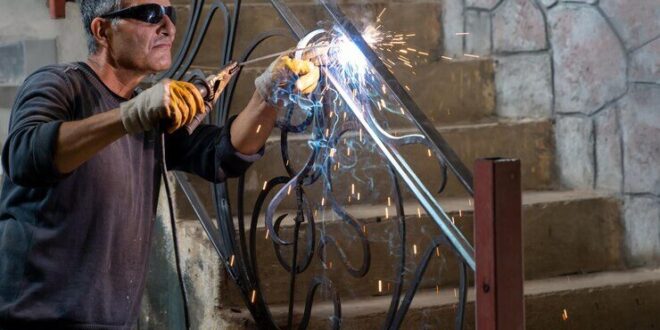Laser welding is becoming prominent and getting more attention than conventional welding methods. However, many people, especially those who don’t align themselves with new technologies, are skeptical about the strength of laser welds.
So, is laser welding strong? Yes, it is reliable, robust, and offers very durable welds. The keyhole method of laser welding provides a fusion of metals (welds and joints) that will last years. It will be strong enough to bear any shocks and falls.
This guide compares the strength of laser weldings with conventional ones, giving you a better idea of their strength.
Are Laser Welds Powerful to Bear Shocks?
Yes, the laser welds can easily bear the severe shocks and falls. Thanks to the powerful and highly focused laser beam that melts the metal quickly and joins two metals together. These welds are designed to endure for many years.
It is important to note that there are many types of laser welding. Each offers different strengths in welding. For example, the heat conduction type offers slightly less strong welds but gives smoothness at the joins.
Conversely, the keyhole laser welding method offers very durable, strong joints. These joints are so strong that if you strike anything on these joints, they won’t break. If the strength of welding is your priority, I recommend you choose the keyhole method for your work or task.
What Factors Contribute to the Strength of Laser Welding?
Among all the types, keyhole welding is the strongest. Many factors contribute to the strength of this type of laser welding. Learn more about some factors that influence the strength of laser welding.
- Power Density: The laser beam has a very high power density, and when it strikes the metal, it penetrates deep inside it. Their penetration creates a hole, which makes the fusion of two metals very strong.
- Beam Focus & HAZ: The laser beam usually remains focused and highly targeted at a small part of the metal. It reduces the HAZ, puts all the energy at one point, and effectively melts or evaporates the metal. The hole is created due to the vaporization of metal filled with filler. This results in a powerful fusion of metals.
- Joint Design: The keyhole laser welding creates holes that fill with filler. This combination of the hole and its fill results in a stable collaborative design, avoiding awkward shapes and ensuring long-term stability at its location for years to come.
- Control and Monitoring: Laser welding is a very controlled method. Users can adjust the heat and keep the lasers very specific at one point. This ability helps metals melt and stick together fast, making joining them quick and efficient. Once the metals cool, they become solid and look like a single, solid piece.
How Does Laser Welding Compare to Traditional Welding Methods?
Traditional welding methods include MIG (Metal Inert Gas) and TIG (Tungsten Inert Gas) weldings. But the question is: is laser welding stronger than TIG and MIG welding? In the upcoming section, I will compare the strength of laser welding with conventional methods.
Is Laser Welding as Strong as MIG?
Yes, the laser welding method (keyhole) is stronger than conventional MIG welding. Lasers offer more focused, intense heat waves that melt the metal quickly, filling the gap with filler and resulting in the strongest bond.
I am not against MIG welding, as it does an excellent job. Both of these methods of welding are used at the commercial level. However, when you compare these methods neck to neck, the last weldings offer slightly better strength due to focused beams that create holes filled by the filler.
However, the heat conduction method of laser welding is not as robust as the MID weldings. Whether you are welding a thicker or thinner material, the heat conduction method will always offer weaker fusion and bonding of two metals. I suggest you prioritize MIG over heat conduction methods.
Is Laser Welding as Strong as TIG?
Laser welding offers the strongest welds possible in Tungsten Inert Gas Welding. If the laser operator is fully trained and operates the laser better, the welds will be even stronger.
Both TIG and laser welding are equally strong. However, I suggest you prioritize laser welding due to performance, even if you don’t use the filler. You must use the filler in both TIG and MIG welding. In MID, the filler will act as an electrode. In TIG, you’ll need a separate electrode and filler in the form of wire.
Is Laser Welding an Effective Joining Method?
All welding methods, including laser, TIG, and MIG, work effectively and join two pieces of metal. However, their effectiveness and cost vary. TIG And MIG are cheaper solutions for welding, but they are less effective than the keyhole laser welding method.
Laser welding, especially its keyhole type, is proven very effective due to its ideal strength. The other conventional methods produce welds or joints that are slightly weaker; they do not withstand shocks as effectively as the laser method.
Laser welding methods are very effective in durability and strength. However, they are slightly more expensive than traditional ones. So, would you save a penny or opt for high performance? The choice is yours!
Conclusion
Laser welding is solid and offers very durable welds, joints, and connections between two pieces of metal. However, the initial cost of a laser welding machine is so high that it could be an issue for someone with a tight budget. However, the machine’s high price is worth it as it offers ideal performance in less time.
 HammBurg Be informed with latest news, reviews, entertainment, lifestyle tips, and much more.
HammBurg Be informed with latest news, reviews, entertainment, lifestyle tips, and much more.




